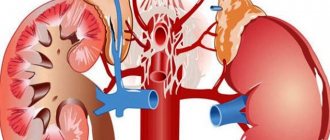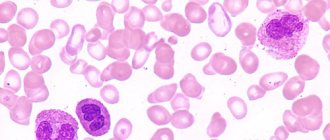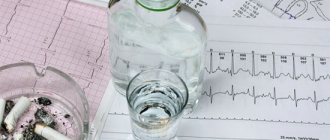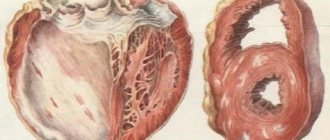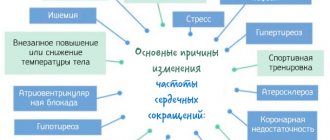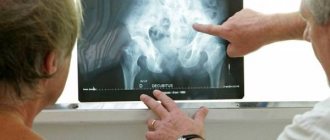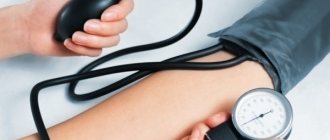Arterial hypertension is a complex disease that occurs as a result of a persistent increase in arterial and venous pressure to numbers higher than 140/90. High blood pressure is the scourge of our time, since mortality from cardiovascular diseases is now in first place, according to WHO. As is known, arterial hypertension is widespread in Russia. The problem of combating it is now more relevant than ever. Thus, it is necessary to understand what risk factors for hypertension currently exist.
Patients with arterial hypertension develop a number of fatal diseases that lead to a significant deterioration in the patient’s quality of life. In particular, with the aggressive development of hypertension and lack of control by a specialist, a list of serious diseases may develop. For example, it could be coronary heart disease, stroke, heart attack, chronic heart failure. As a result, all this leads to a significant reduction in human life expectancy.
In this regard, it is necessary to know and understand the totality of what situations, diseases and factors lead to the emergence and development of arterial hypertension. This series of conditions that can influence the initial manifestation and further development of hypertension are risk factors for hypertension.
Previously, according to Russian standards, nine main risk factors for the development of hypertension were identified. But since 2020, the European Society of Cardiology has revised its recommendations for the diagnosis and treatment of arterial hypertension. As a result, four more risk factors for arterial hypertension were added to the existing ones. As a result, thirteen risk factors are currently identified, the presence of which can provoke the development of arterial hypertension.
The risk factors themselves are divided into two categories: 1) Controllable risk factors are those risk factors that we can influence. As an example, these could be: obesity, smoking, stress, high cholesterol. 2) Uncontrollable risk factors - these include those factors that we are not able to influence. An example of an uncontrollable risk factor may be heredity, age, or early onset of arterial hypertension.
The main risk factors for hypertension according to European recommendations:
1) Gender 2) Age 3) Current or former smoking 4) Level of total cholesterol and LDL (low-density lipoprotein in the lipid profile) 5) Diabetes mellitus 6) Obesity or overweight 7) Previous development of cardiovascular diseases in the patient 8) Sedentary lifestyle 9) Early development of hypertension in the patient or his parents and new risk factors: 10) The value of uric acid levels 11) Menopause, which occurred quite early 12) Psychosocial and socio-economic factors 13) Resting heart rate above 80 beats per hour minute.
Let's look at all the risk factors for hypertension separately. This will help to understand how each of them specifically affects the development of arterial hypertension.
Diagnostics
The diagnosis of hypertension is made based on blood pressure values if they do not fall below 180/100 mmHg for a long time. When diagnosing, patient complaints are very important. If he experiences nausea, dizziness, swelling, weakness in the body, increased heart rate, then he definitely needs medical supervision.
To obtain the correct data, the patient must visit a specialist within two weeks and have their blood pressure measured twice. This is how stage 3 and stage 2 hypertension is diagnosed. This allows you to determine the presence of edema in the peripheral vessels. This type of technique allows you to listen to the heart and calculate its configuration.
If, after undergoing a series of examinations, stage 3 hypertension was diagnosed, this means that there is a high risk of suffering from complications of this disease. To prevent serious consequences from occurring, appropriate treatment measures must be taken urgently. Otherwise, grade 3 hypertension (risk 3) may cause disability.
There are four risk groups, which are determined by the percentage of probability of damage to the cardiovascular system and aggravating factors.
| At-risk groups | Explanation |
| First (low risk) | Within 15%, with no aggravating factors. |
| Second (middle) | 15-20% with the presence of no more than 3 aggravating factors. |
| Third (high) | Up to 30% and over 3 aggravating factors. |
| Fourth (very high) | From 30% and above, along with this there is damage to the organs of the cardiovascular system and more than 3 aggravating factors. |
Among the aggravating factors are excess weight, smoking, chronic stress, diabetes mellitus, lack of physical activity, poor diet, and endocrine pathologies.
Hypertension stage 3, risk 2 . This stage is characterized by attacks of angina pectoris, sleep disturbances and heart rhythm disturbances. When examining patients, many are found to have damage to internal organs. To confirm the diagnosis of stage 3 hypertension (second risk), blood and urine donation, ECG, ophthalmoscopy, ultrasound, EEG, urography, and CT scan of the kidneys may be prescribed.
Hypertension grade 3, risk 3 . This form of the disease poses a serious danger to human health and life. Arterial hypertension of the 3rd degree (third risk) even threatens with disability. It can cause problems with the heart, brain, kidneys or retina.
Even stage 2 hypertension with the same risk can lead to irreversible disorders due to the presence of aggravating factors. To minimize the risk of stage 3 in stage 3, do not neglect the recommendations of doctors and, if necessary, immediately contact a medical institution.
Hypertension stage 3, risk 4 . May result in speech or motor impairment, including paralysis. In this case, the person is no longer able to cope without the help of strangers. He needs constant care and extra attention. His health is deteriorating every day, as the disease affects new organs and systems.
The exact diagnosis is announced after a physical examination (listening to the heart using a phonendoscope), electrocardiogram, ultrasound, arteriography, Dopplerography, examination of the kidneys and thyroid gland.
Patient gender
Men are much more predisposed to developing hypertension than women. As a result, their onset of the disease usually occurs earlier - before 55 years of age (usually 35-55 years). Thus, during this period, an exacerbation of the disease most often occurs. In women before menopause, estrogen protects blood vessels and the heart. That is why the onset of the disease in women occurs 10-15 years later than in men. As soon as menopause begins and a hormonal imbalance occurs in the body, cases of hypertension are possible. Due to the fact that hypertension occurs in women at a later age, it is much more difficult to tolerate.
First degree hypertension (mild form)
The initial degree of hypertension is determined by a smooth, slight increase in blood pressure and its gradual decrease. Blood pressure readings are 140–160 mmHg. (systolic pressure) and 90–99 mmHg. (diastolic).
Degrees of increase in blood pressure
The symptoms of the disease at stage 1 are not clearly expressed. Many people do not know that they have high blood pressure and live a normal life. The pathology develops without pronounced symptoms.
The initial form of the disease is characterized by symptoms such as:
- periodic headaches;
- darkening of the eyes;
- noise in ears;
- increased fatigue.
Treatment of the disease at the initial stage does not require medication.
At this stage, the disease is treated by following a set of measures:
- diet – food should be healthy and wholesome. Be sure to eat porridge, dairy products, fresh vegetables, fruits;
- The menu contains less salt - no more than 5 g per day;
- giving up alcohol and smoking;
- compliance with the work and rest regime;
- fight against excess weight;
- stabilization of psycho-emotional state.
Age
Age is a fairly common risk factor for hypertension. First of all, because we cannot influence it in any way. As we age, our lifestyle begins to take its toll and the so-called “mistakes of youth” begin to appear. The walls of blood vessels become less flexible and elastic due to the fact that collagen gradually accumulates in them. The wall begins to thicken. As a result, increased wall rigidity leads to the fact that the speed of blood flow in the body begins to increase, which gradually leads to an increase in pressure.
In addition, throughout our entire life the growth and accumulation of cholesterol plaques in the blood vessels occurs in our body. The older we get, the more they accumulate. If large atherosclerotic plaques are not detected in a timely manner, this can lead to thrombosis, heart attacks and strokes. If you have high cholesterol, do not skip statin therapy prescribed by your doctor.
You can refer to statistics from the World Health Organization on the prevalence of arterial hypertension according to age criteria. This helps to clearly see how age affects the development of hypertension.
According to the WHO (World Health Organization), 7% of the population aged twenty to twenty-nine suffers from hypertension. Then the percentage is higher: thirty-year-olds now make up more than 16%. And this is already twice as much. After forty, this is already one in four. Well, after fifty years, every third person in the world suffers from hypertension.
There is no need to be afraid of your age. You just need to sensibly understand that the older we get, the more attention and control our body requires.
Symptoms of hypertension
The development of hypertension is often asymptomatic. Many patients receive a diagnosis of hypertension only when they visit a specialist for a routine examination. You should listen to your body and pay attention to any deviations and changes in well-being.
Common signs of hypertension:
- headaches;
- fast or slow heartbeat;
- dizziness;
- swelling of the limbs, face;
- impaired brain activity, memory loss;
- numbness of fingers;
- facial hyperemia;
- chills;
- hyperhidrosis;
- anxiety;
- nervous excitement;
- decreased performance;
- nervousness, aggression;
- black spots before the eyes.
With hypertension, symptoms do not appear regularly, but sporadically. The appearance of one of the signs of the disease is a reason to consult a doctor. The main sign that indicates the development of the disease is a regular increase in blood pressure. Blood pressure in hypertension is elevated most of the time, regardless of precipitating factors.
For hypertension, it is important to start treatment on time. Untimely medical care can lead to the progression of hypertension, serious health problems and pathologies. Experts recommend measuring blood pressure with a tonometer twice a day. Regular measurements will tell you about the course of hypertension and help determine the stage and type.
Before measuring blood pressure, you should not smoke, drink alcohol, or drink coffee. You need to sit comfortably in a chair or chair, relax, and then alternately measure the pressure on each arm. The cuff is attached one finger above the elbow joint. The pulse is best felt in this area.
How to measure pressure correctly
When taking measurements, it is necessary to focus on existing standards for pressure indicators. They are individual for each age:
- 16-20 years: 100/70-120/80;
- 20-40 years: 120/70-130/80;
- 40-60 years: 135/85;
- after 65 years: 140/90.
If your blood pressure increases above normal for several days, you should consult a doctor. The specialist will conduct a comprehensive examination to exclude or diagnose hypertension.
Elevated cholesterol levels
Normally, our body needs cholesterol and must come from food. Cholesterol lipoproteins are involved in the functioning of the membranes of all cells in our body. So why is high cholesterol harmful? As a result of poor nutrition, bad habits and a sedentary lifestyle, too much cholesterol can enter our body, resulting in an increase in low and very low density lipoproteins. When there are a lot of them, the body stops recognizing them and begins to consider them foreign cells. As a result, an inflammatory reaction occurs in the walls of blood vessels, which leads to the formation of cholesterol (or atherosclerotic) plaque. Such plaques can gradually grow, closing the lumen of the vessel and disrupting blood flow to organs and tissues.
The second risk is the risk of thrombosis. The plaque can break off and travel through the bloodstream until it clogs one of the vessels. This is an approximate mechanism for the development of thrombosis, heart attacks and ischemic strokes.
How we can protect ourselves is by periodically monitoring cholesterol levels. It is desirable that this be a lipid profile, which indicates not just the level of cholesterol, but its content in the blood by fraction. Plus, if you are at risk and have elevated levels of LDL (low-density lipoprotein) or triglycerides, then you need to follow a diet and take medications that help normalize cholesterol and triglyceride levels (these are statins and fenofibrate).
Therapy for hypertension
Hypertension 1st degree
With stage 1 hypertension, blood pressure rises periodically rather than regularly. It increases for a short period of time and returns to normal within a few hours without drug intervention. Signs of hypertension:
- headaches;
- dizziness;
- tinnitus;
- black spots before the eyes.
The first stage can be cured without drug intervention. It is necessary to consult a doctor who will give recommendations for the treatment of hypertension. Usually it is enough to change your eating habits, normalize your daily routine, lose excess weight, and get rid of bad habits. For stage 1 hypertension, it is useful to spend more time in the fresh air, include light exercise, not worry and avoid stressful situations.
Non-drug therapies for hypertension
Additionally, a specialist may recommend health procedures:
- reflexology;
- massage;
- physiotherapy;
- phytotherapy.
The doctor prescribes treatment with antihypertensive drugs if other methods of treatment fail and the disease progresses.
Hypertension 2 degrees
Hypertension in humans is not a rapidly progressing disease. Several years may pass from the transition of the first degree of hypertension to the second. At stage 2, the patient increasingly develops alarming symptoms:
- gagging;
- dizziness;
- headaches;
- numbness of the limbs;
- rapid fatigue;
- rapid heartbeat.
At stage 2, the doctor prescribes medications. The dosage, course duration, and type of drug are selected by a specialist individually according to indications after examination. The patient takes the medications continuously for the specified period, even if the pressure has stabilized. At stage 2, diuretics are prescribed. They remove excess water, relieve tissue swelling, and dilate blood vessels.
The effect of diuretics can be enhanced with angiotensin-converting enzyme inhibitors. They act directly on blood vessels, reducing the production of angiotensin 2, an enzyme that constricts blood vessels.
Help for hypertension includes the prescription of anticoagulants and cholesterol-lowering drugs.
Therapy is selected individually. The doctor conducts a comprehensive examination, identifies the cause and bases treatment on ridding the patient of the provocateur. Quick, positive results can be achieved by prescribing complex, combination therapy, which includes drug intervention and lifestyle correction.
There are a lot of medications for high blood pressure; only a doctor can prescribe the right ones
Hypertension 3 degrees
If target organs are damaged, the doctor diagnoses “stage 3 hypertension.” Help for stage 3 hypertension is more aimed at treating organs and vital systems; the specialist pays attention to blood pressure last.
Stage 3 hypertension develops due to late consultation with a doctor and lack of therapeutic assistance, so scheduled annual examinations with a visit to a cardiologist cannot be ignored. Modern diagnostic examinations make it possible to determine abnormalities in the functioning of the heart and blood vessels at the initial stage. This allows specialists to detect hypertension at an early stage.
If you have hypertension, you will have to take medication for the rest of your life. This will help stop the progress of the disease, delay it in the second stage, and improve the quality of life.
At stage 3, symptoms become severe. The main symptomatic manifestations of hypertension include damage to internal organs, blood vessels, and cells of the nervous system. At stage 3, the likelihood of a heart attack and unstable blood circulation increases. The risks of hypertension include kidney damage, development of kidney failure, and damage to the eyes.
If internal organs are damaged, therapy becomes more difficult, and it is not possible to cure the patient. At stage 3, the patient is prescribed complex therapy, which includes medications, lifestyle correction, dietary nutrition, and wellness procedures.
Hypertension in old age
Hypertension in old age requires special treatment. In adulthood, blood pressure levels, the type of medications, and general recommendations change. Patients require gentle treatment, since internal organs and vital systems can no longer tolerate increased therapeutic loads.
The doctor selects medications for each elderly patient individually, taking into account the specific course of the disease, pathogenesis, and concomitant disorders in the body.
In the absence of complications, the patient is prescribed thiazide diuretics. Starting from the age of 50, thiazides are more effective. Diuretics are prescribed at a minimum dosage, which is gradually increased to achieve the required therapeutic effect. Exceeding the dosage can cause an increase in “bad” cholesterol in the blood, which will lead to the formation of plaques.
If there is a lack of potassium, the doctor prescribes potassium-sparing drugs to the patient who suffers from hypertension. Additionally, potassium-containing medications should not be taken in old age.
The doctor selects therapy taking into account the patient’s age
Diuretics have contraindications that must be taken into account when prescribing. If the patient cannot take diuretics, the doctor prescribes beta blockers.
Angiotensin-converting enzyme blockers and inhibitors are not as effective, but they will help normalize the condition if other treatments do not work. In rare cases, the doctor may resort to prescribing potent medications from the group of blockers: Guanabenz, Clonidine, Methyldopa, alpha-blockers. These drugs are prescribed in exceptional cases, since their use causes drowsiness and depression. Hypotension may develop while taking these drugs.
To treat low-renin arterial hypertension, the doctor prescribes calcium channel blockers. They help normalize blood supply to the brain, internal organs, and kidneys. Calcium antagonists prevent the development of angina and cardiovascular disorders.
In old age, you can quickly reduce blood pressure with combination medications. These are medications that contain several active ingredients. The doctor may prescribe complex therapy, which includes several drugs from different pharmacological groups. Effective complexes for reducing blood pressure:
- diuretics + calcium channel blockers;
- beta blockers + diuretic;
- ACE inhibitors + calcium channel blockers;
- ACE inhibitors + diuretics.
In case of a hypertensive crisis, it is important to quickly normalize the patient’s condition. After therapy, it is recommended to visit a sanatorium or health resort. The following health procedures will be useful:
- exercise therapy;
- diet;
- therapeutic mud baths;
- hardware physiotherapy;
- treatment with medicinal plants;
- aromatherapy;
- drug treatment;
- oxygen cocktails.
Doctors recommend including procedures that use electric current: electrosleep, electrophoresis, laser therapy. Electrical impulses lower blood pressure and normalize the functioning of the heart and kidneys.
Hydrogen sulfide and carbon dioxide baths restore the immune system and normalize blood pressure.
Health treatments are selected by medical professionals according to the patient’s indications and condition.
At any age, moderate physical activity is recommended for hypertension
Traditional methods
Drug therapy will be incomplete without additional measures. Doctors recommend combining drug treatment with traditional methods of treating hypertension. These are simple herbal recipes that help quickly normalize blood pressure.
- Red clover tea drink. Clover flowers are brewed in boiling water and taken half a glass daily before bed. It is recommended to prepare a fresh drink each time. The shelf life of ready-made clover tea is 3 days; the finished tea should be stored in the refrigerator.
- Garlic-honey composition. Add 5 chopped garlic cloves and grated lemon along with zest to half a glass of honey. Mix the resulting mixture and place it in a dark place for 7 days. The resulting mixture is taken three times a day, 1 teaspoon. It is recommended to store the product in the refrigerator in a closed container.
- Vegetable juice. You will need: carrots, beets, black radish, honey, lemon. Squeeze 1 glass of juice from each vegetable, including lemon, mix with a glass of honey. Take the resulting mixture 3 times a day before meals. The duration of therapy is 45 days.
- Rosehip infusion. Sold ready-made in a pharmacy. There are no restrictions on admission.
- Sunflower seeds. We wash the seeds under running water, pour them into a saucepan and fill them with 1.5 liters of cold water. Boil over low heat for 2 hours. The resulting decoction is taken 1 glass per day. Before taking, the decoction must be strained.
- Golden mustache. Finely chop the plant and pour in 0.5 liters of vodka. Infuse the resulting composition for 12 days in a dark place, shaking the contents every 3 days. Take 1 teaspoon of tincture 30 minutes before meals.
- Lemon based tincture. To prepare the infusion you will need 50 g of lemon zest, 1 glass of white onion juice, 1 glass of honey. Mix the ingredients with the crushed zest, close tightly, and place in a dark place. The tincture is taken 1 teaspoon 2-3 hours after meals. Another recipe with lemon includes pureed cranberries. You need to mix the zest with cranberries, add a spoonful of rose hips and 1 glass of honey. The resulting composition is taken 1 tablespoon in the morning and evening.
- Honey infusion of two compositions. First composition: mix 500 grams of May honey with 0.5 liters of vodka, heat the mixture until foam forms over low heat, stirring constantly, infuse. The second composition includes chamomile, marsh grass, valerian, knotweed, and motherwort. We brew a pinch of plants in a liter of water, infuse, strain and add to the first composition. We put the tincture in a dark place for three days. In the first 7 days, take the infusion 2 times a day, 1 tsp. Then the dosage is increased to 1 tbsp. in one go.
Folk remedies provide good support for drug treatment of hypertension
Diet
An effective remedy for hypertension is dietary nutrition. Obesity and excess weight increase blood pressure. For 1 kg of excess weight there are 1-2 points on the tonometer. It is necessary to bring the weight into compliance with the standards. To do this, the doctor prescribes dietary nutrition in combination with other corrective measures:
- Reduce the amount of salt you consume. Table salt contains sodium, which retains water. Water increases the volume of circulating blood, which leads to increased blood pressure. You are allowed to consume no more than 4 g of salt per day.
- To improve metabolism, you need to drink more clean water. The body needs at least 1.5 liters per day.
- You cannot drink alcohol, strong tea or coffee.
- The daily diet for hypertension should be divided into 5-8 meals. You need to eat in small portions, without overeating. There should be an interval of at least 3-4 hours between meals.
- It is necessary to reduce the consumption of meat and animal fats. It is allowed to eat lean, dietary meat: turkey, chicken, rabbit, veal. The meat should be cooked without using oil; you can add a little herbs or lemon juice instead of salt. Smoked products, sausages, and butter should be excluded from the diet.
- It is necessary to eat more fresh vegetables, fruits, potassium- and magnesium-containing foods: cereals, beets, carrots, dried apricots, cabbage.
- Allowed sweets: dried fruits, honey, whole grains. You need to give up confectionery products.
- If you have hypertension, you cannot fast or follow a strict diet. The patient should receive a complete, balanced diet every day.
Diabetes
Diabetes mellitus is a fairly serious disease, but it is also a risk factor for hypertension, heart attacks and strokes.
For example, in the case of the development of an insulin-dependent form of the disease, hypertension in most cases develops directly due to impaired renal function and the development of the so-called “diabetic kidney”. Over time, elevated sugar levels cause vasoconstriction, including in the kidneys themselves, gradually disrupting the structure of the glomeruli of the kidneys, which leads to the development of diabetic nephropathy. The renin-angiotensin system, which has a huge impact on blood pressure control, is directly dependent on the condition of the urinary system. As a result of the disruption of the kidneys, it also ceases to function adequately. As a result, arterial hypertension develops.
If the patient has non-insulin-dependent diabetes, then hypertension develops in some cases much earlier than other metabolic diseases.
Reasons for development
Excess weight is the main source of high blood pressure
Hypertension is a disease that does not occur on its own.
Reasons are needed for its appearance. The most common are:
- overweight, obesity;
- dysfunction of the thyroid gland;
- kidney disease;
- magnesium deficiency in the body;
- heredity;
- nervous tension;
- long-term use of birth control pills;
- bad ecology;
- abuse of bad habits;
- poor nutrition;
- congenital heart defects, etc.
Obesity and overweight
Increased weight is currently considered one of the main risk factors for the development of blood pressure. Adipose tissue is an endocrine organ that is capable of producing a number of hormones. In particular, visceral fat is capable of secreting angiotensinogen, a hormone that increases blood pressure. Thus, overweight people are much more likely to suffer from hypertension than their peers with normal weight. Plus, obesity is very often accompanied by other metabolic disorders, which leads to a deterioration in the patient’s condition. How to understand whether you have obesity and how to deal with it is written in detail in the article on diet No. 10 for hypertension.
Forecast
At stage 3 hypertension is extremely serious. It is determined by the probability of fatal complications occurring in 30-60% within 5 years or even less.
The higher the number of unfavorable factors, the higher the numbers:
- Burdened heredity.
- Smoking, alcoholism.
- Drug addict.
- Obesity.
- Metabolic disorders.
- Somatic pathologies.
- Physical inactivity.
- Poor nutrition.
Causal treatment is aimed at eliminating the root cause, symptoms and risk factors. With an integrated approach, it is possible to “drive” the value within the framework of 15-20%.
Previous development of cardiovascular diseases in a patient
This risk factor for hypertension can be combined with a similar factor, “Early development of hypertension in the patient or his parents.” They have approximately the same explanation. Both of these factors are directly related to heredity.
It is a well-known fact that some diseases are transmitted from parents to children. In this case, the gene for the early development of arterial hypertension, unfortunately, dominates the gene responsible for the normal development of the trait. Thus. If both parents are hypertensive, then the risk of developing hypertension in the heir is very high. If one or both parents have an early onset of the disease, then, unfortunately, this factor is most likely to be passed on to the child, who is also likely to develop hypertension at an early age.
To do this, during the survey, the therapist and cardiologist always clarify whether the parents have cardiovascular diseases. This survey allows you to exclude or, conversely, find out the presence of a genetic predisposition to the early onset of hypertension. How will this help the patient? He will be aware that he needs to control his blood pressure and be on alert.
Prevention methods
Preventive measures are aimed at reducing risk factors for hypertension:
- maintaining weight within normal limits;
- reducing consumption of salty foods;
- quitting smoking and alcohol;
- avoidance of stressful situations;
- moderate physical activity;
- adding activity to a sedentary lifestyle;
- therapy of chronic diseases.
To reduce the risk of complications of hypertension, you must constantly take antihypertensive drugs prescribed by your doctor. Antihypertensive drugs are taken in a course.
Sedentary lifestyle or physical inactivity
Physical inactivity is a sedentary lifestyle and lack of physical activity on the body. In the early stages of physical inactivity, a person notices lethargy, drowsiness, and decreased performance. Insomnia may develop quickly, fatigue often sets in, and the patient begins to notice increased heartbeat. In the future, obesity may develop. First of all, the development of vegetative-vascular dystonia may occur, then a blow to the cardiovascular system occurs, as blood circulation in organs and tissues is disrupted.
We have been taught to prevent physical inactivity since childhood - remember the five-minute periods in class? When the children got up from their seats and performed a set of simple exercises. If you find yourself thinking that you are leading a sedentary lifestyle, then make it a rule to take short breaks from work. Are you embarrassed to do exercises? Walk around the office - water the flowers, go up and down the stairs. It doesn't take much time, but it is very helpful in combating a sedentary lifestyle and helps keep your cardiovascular system in good shape.
How to recognize hypertension at an early stage
In the early stages, the characteristic illness has unexpressed symptoms, for example, attacks are accompanied by dizziness from increased physical exertion, in a state of emotional overstrain. The patient experiences weakness, internal discomfort, and after the onset of the disease, complaints of headache attacks appear, which are temporary. Other initial symptoms of high blood pressure in men and women are presented below:
- decline in performance, increased drowsiness;
- decreased concentration;
- the appearance of spots in the eyes;
- loss of appetite;
- increased sweating;
- nosebleeds;
- unexpected paleness of the face;
- feeling of anxiety;
- chronic insomnia;
- signs of memory impairment.
Elevated uric acid levels
Nowadays, quite a lot of attention is paid to such an indicator as the level of uric acid. In 2013, an amendment was made to the Russian recommendations for the treatment of arterial hypertension to the effect that all patients with high blood pressure must have their uric acid levels measured. A prolonged increase in uric acid levels, which is accompanied by joint pain, helps to identify and diagnose gout in a timely manner.
It would seem, what is the connection? An increase in uric acid levels causes oxidative stress in blood vessels, disrupting tissue microcirculation. As a result, ischemic disorders occur, leading to a malfunction of many body systems, including the cardiovascular system. Thus, timely control of uric acid levels will help prevent the development of more serious diseases. This is especially important against the background of metabolic syndrome, consumption of large amounts of meat products, and alcohol.
Early menopause
In the event of early menopause, women develop a deficiency of the hormones estrogen and progesterone, which leads to disruption of the hypothalamic-pituitary system. And disruption of progesterone synthesis in the body leads to disruption of the regulatory mechanism of vascular tone. Estrogen deficiency contributes to increased insulin resistance, which is a risk factor for the development of obesity and diabetes.
In addition, in the case of the development of arterial hypertension in postmenopausal women, they speak of a significant increase in the rigidity of the vascular walls. Thus, a whole cascade of metabolic disorders develops, which can directly or indirectly lead to the development of arterial hypertension.
In cases of early menopause, women are usually prescribed hormone therapy. In case of intolerance, therapy that replaces hormonal drugs with herbal preparations. It is also recommended to follow a diet and take a list of medications that have a preventive effect on the development of arterial hypertension and diabetes. Much in such cases in postmenopausal women depends on correctly recommended preventive measures. They help prevent and reduce the risk of developing hypertension, obesity, diabetes and their complications, improve the quality of life and its duration.
Resting heart rate over 80 beats per minute
This indicator also received close attention. This is due to the fact that a number of global studies involving more than 30 thousand patients have come to an end. In these studies, heart rate (cardiovascular heart rate) acts as a separate risk factor.
Thus, it was found that heart rate itself may not depend on blood pressure or cholesterol levels. But the mortality rate in patients with an elevated heart rate at rest turned out to be three times higher than in subjects with this indicator normal. Thus, heart rate is an important prognostic factor for arterial hypertension.
Of course, a single heart rate measurement cannot be such a criterion. First of all, this suggests that it needs to be monitored, just like your blood pressure level. That is, daily measurements are required. It should be noted that heart rate not only in patients with coronary artery disease, but in all groups of patients, regardless of gender and age, can be a prognostic factor regarding life expectancy and quality of therapy.
An increased level of heart rate indicates a violation of the regulatory function of the parasympathetic and sympathetic nervous systems. With a constant increase, it requires mandatory medication adjustment.
Psychosocial and socio-economic factors
In other words, prolonged loads and stressful conditions are also included in a separate risk group. Let's figure out what stress is? Stress is the body's response to external influences of various factors. When stress occurs, our nervous system comes into play. Sometimes even it cannot withstand overloads, and malfunctions occur. In the case of frequent psychological trauma, hypersecretion of adrenaline occurs, which causes a rapid heartbeat. As a result, the heart is forced to work harder, and the pressure increases because of this.
Naturally, in the case of prolonged stress, the heart gets tired of working at its limit. Gradually our vessels become unusable. As a result, what should have been a one-time protection against stress turns into chronic forms. As a result, arterial hypertension may develop.
What to do if you discover risk factors for hypertension? First of all, this indicates that you are at risk of developing arterial hypertension. You need to take control of this moment and try to devote more time to your health. Love yourself and be healthy.

